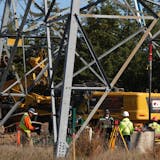"It used to be so pretty driving up that hill to church," Sandi says. "Now, I'm afraid one of those trucks will run me over. I'm not even sure I want to be buried there anymore."
She shrugs and looks at her husband.
"There's new ones going in all the time," he says.
They hate to even consider how many wells will crowd around the Good Hope Cemetery when their day comes and they're laid to rest in plots near Andrew and Amelia in the little church graveyard on the hill.
Curt Brown • 612-673-4767
A pumpjack and storage tanks at a nearby oil pad loomed behind Milo Wisness as he helped coral cattle for branding near Keene, N.D. (The Minnesota Star Tribune)
Oil drilling equipment and methane flames surround the tiny, First Keene Lutheran Church. The cornerstone for the church was laid in 1910. ] (JIM GEHRZ/STAR TRIBUNE) / October 23, 2013, Keene, ND – BACKGROUND INFORMATION- PHOTOS FOR USE IN SECOND PART OF NORTH DAKOTA OIL BOOM PROJECT: Rounding up of cattle and branding calves is a tradition handed down through generations of North Dakotans in the spring each year. Families take turns helping one another carry out the arduous, annual rite all over the state, including in the tiny town of Keene in oil-rich McKenzie County. The scene provides a backdrop for the new wave of workers who have come to the region seeking employment in the Bakken oil fields. Among those living in the area are Paul and Sandi Wisness, whose ancestors came to North Dakota around the turn of the century. Paul and his brother, Milo, own nearly 10,000 acres of land, which includes more than 120 wells (although they do not own all of the mineral rights). (The Minnesota Star Tribune)
Oil operations surround graves at the Good Hope Cemetery at the First Keene Lutheran Church, which include Wisness family grave sites. ] (JIM GEHRZ/STAR TRIBUNE) / October 23, 2013, Keene, ND – BACKGROUND INFORMATION- PHOTOS FOR USE IN SECOND PART OF NORTH DAKOTA OIL BOOM PROJECT: Rounding up of cattle and branding calves is a tradition handed down through generations of North Dakotans in the spring each year. Families take turns helping one another carry out the arduous, annual rite all over the state, including in the tiny town of Keene in oil-rich McKenzie County. The scene provides a backdrop for the new wave of workers who have come to the region seeking employment in the Bakken oil fields. Among those living in the area are Paul and Sandi Wisness, whose ancestors came to North Dakota around the turn of the century. Paul and his brother, Milo, own nearly 10,000 acres of land, which includes more than 120 wells (although they do not own all of the mineral rights). (The Minnesota Star Tribune)
Sandi Wisness waited for her turn at Keene Kuts, where husband Paul Wisness was getting his haircut by Lisa Thompson. ] (JIM GEHRZ/STAR TRIBUNE) / October 23, 2013, Keene, ND – BACKGROUND INFORMATION- PHOTOS FOR USE IN SECOND PART OF NORTH DAKOTA OIL BOOM PROJECT: Rounding up of cattle and branding calves is a tradition handed down through generations of North Dakotans in the spring each year. Families take turns helping one another carry out the arduous, annual rite all over the state, including in the tiny town of Keene in oil-rich McKenzie County. The scene provides a backdrop for the new wave of workers who have come to the region seeking employment in the Bakken oil fields. Among those living in the area are Paul and Sandi Wisness, whose ancestors came to North Dakota around the turn of the century. Paul and his brother, Milo, own nearly 10,000 acres of land, which includes more than 120 wells (although they do not own all of the mineral rights). (The Minnesota Star Tribune)
Paul Wisness (pictured) and his brother, Milo, own nearly 10,000 acres of land in McKenzie County, which includes more than 120 wells (although they do not own all of the mineral rights). ] (JIM GEHRZ/STAR TRIBUNE) / October 23, 2013, Keene, ND – BACKGROUND INFORMATION- PHOTOS FOR USE IN SECOND PART OF NORTH DAKOTA OIL BOOM PROJECT: Rounding up of cattle and branding calves is a tradition handed down through generations of North Dakotans in the spring each year. Families take turns helping one another carry out the arduous, annual rite all over the state, including in the tiny town of Keene in oil-rich McKenzie County. The scene provides a backdrop for the new wave of workers who have come to the region seeking employment in the Bakken oil fields. Among those living in the area are Paul and Sandi Wisness, whose ancestors came to North Dakota around the turn of the century. Paul and his brother, Milo, own nearly 10,000 acres of land, which includes more than 120 wells (although they do not own all of the mineral rights). (The Minnesota Star Tribune)
The landscape around Keene and throughout the Bakken oil fields reflects the change brought on by the boom. ] (JIM GEHRZ/STAR TRIBUNE) / October 23, 2013, Keene, ND – BACKGROUND INFORMATION- PHOTOS FOR USE IN SECOND PART OF NORTH DAKOTA OIL BOOM PROJECT: Rounding up of cattle and branding calves is a tradition handed down through generations of North Dakotans in the spring each year. Families take turns helping one another carry out the arduous, annual rite all over the state, including in the tiny town of Keene in oil-rich McKenzie County. The scene provides a backdrop for the new wave of workers who have come to the region seeking employment in the Bakken oil fields. Among those living in the area are Paul and Sandi Wisness, whose ancestors came to North Dakota around the turn of the century. Paul and his brother, Milo, own nearly 10,000 acres of land, which includes more than 120 wells (although they do not own all of the mineral rights). (The Minnesota Star Tribune)
Ray Gilstad, 79, escaped from the heat of a hot, July afternoon sun while haying in a field near his home in Keene, ND. Gilstad owns 1,520 acres of land.] (JIM GEHRZ/STAR TRIBUNE) / October 23, 2013, Keene, ND – BACKGROUND INFORMATION- PHOTOS FOR USE IN SECOND PART OF NORTH DAKOTA OIL BOOM PROJECT: Rounding up of cattle and branding calves is a tradition handed down through generations of North Dakotans in the spring each year. Families take turns helping one another carry out the arduous, annual rite all over the state, including in the tiny town of Keene in oil-rich McKenzie County. The scene provides a backdrop for the new wave of workers who have come to the region seeking employment in the Bakken oil fields. Among those living in the area are Paul and Sandi Wisness, whose ancestors came to North Dakota around the turn of the century. Paul and his brother, Milo, own nearly 10,000 acres of land, which includes more than 120 wells (although they do not own all of the mineral rights). (The Minnesota Star Tribune)
Ray Gilstad, 79, looked over a sea of Angus cattle as they were rounded up for branding on the Doug Olson ranch near Keene, ND. Gilstad has been coming to the Olson’s annual branding for 70 years.] (JIM GEHRZ/STAR TRIBUNE) / October 23, 2013, Keene, ND – BACKGROUND INFORMATION- PHOTOS FOR USE IN SECOND PART OF NORTH DAKOTA OIL BOOM PROJECT: Rounding up of cattle and branding calves is a tradition handed down through generations of North Dakotans in the spring each year. Families take turns helping one another carry out the arduous, annual rite all over the state, including in the tiny town of Keene in oil-rich McKenzie County. The scene provides a backdrop for the new wave of workers who have come to the region seeking employment in the Bakken oil fields. Among those living in the area are Paul and Sandi Wisness, whose ancestors came to North Dakota around the turn of the century. Paul and his brother, Milo, own nearly 10,000 acres of land, which includes more than 120 wells (although they do not own all of the mineral rights). (The Minnesota Star Tribune)
Jeff Hepper and one of his daughters, Kari, 6, helped to round up cattle for their neighbor, rancher Doug Olson. Branding at the Hepper’s ranch was delayed due to rain. ] (JIM GEHRZ/STAR TRIBUNE) / October 23, 2013, Keene, ND – BACKGROUND INFORMATION- PHOTOS FOR USE IN SECOND PART OF NORTH DAKOTA OIL BOOM PROJECT: Rounding up of cattle and branding calves is a tradition handed down through generations of North Dakotans in the spring each year. Families take turns helping one another carry out the arduous, annual rite all over the state, including in the tiny town of Keene in oil-rich McKenzie County. The scene provides a backdrop for the new wave of workers who have come to the region seeking employment in the Bakken oil fields. Among those living in the area are Paul and Sandi Wisness, whose ancestors came to North Dakota around the turn of the century. Paul and his brother, Milo, own nearly 10,000 acres of land, which includes more than 120 wells (although they do not own all of the mineral rights). (The Minnesota Star Tribune)


